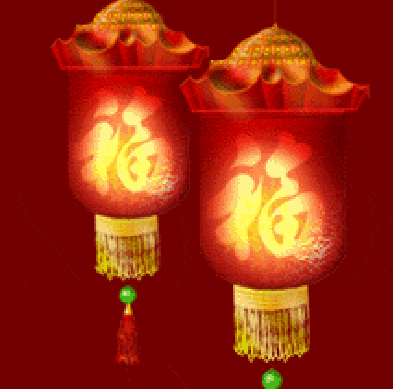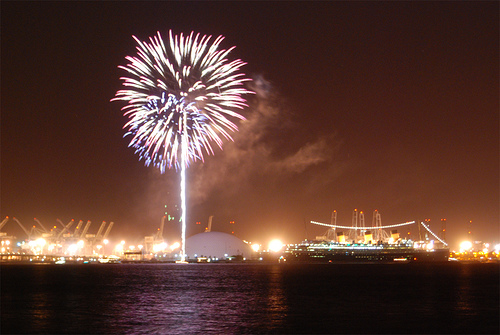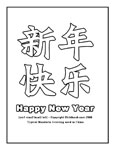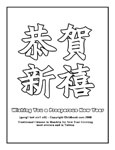
HISTORY OF CHINESE NEW YEAR
Transliterated by: "Michael AngelOh"
transport back to
happy chinese new year lunar calendar history and traditions navigation directory

Chinese New Year History
"Chinese New Year History" records that Chinese New Year is the longest and most important celebration on the Chinese calendar. Chinese New Year celebrations usually commence on the first day of the month and continue through the 15th day of the month. Chinese months are discerned according to the lunar calendar with the first day of the month being the darkest day and the 15th day when the moon is at it's brightest. In most Chinese communities, the celebrate of the Chinese New Year people can take weeks of preparation. The "Chinese Year of 4706" began on February 7th, 2008.

CHINESE NEW YEAR TRADITIONS
Transliterated by: "Michael AngelOh"
transport back to
happy chinese new year lunar calendar history and traditions navigation directory

The Legendary "Chinese New Year Traditions" of the original Chinese New Year has been proported to have it's origin in ancient times when Buddha asked animals to meet him on Chinese New Year. Twelve animals came and Buddha named a year after each one of them. He then pronounced that the people born in a specific animal year would have some of that animals personality characteristics. Those born in the rat's years tend to be leaders, pioneers, and conquerors. They are charming, passionate, charismatic, practical and hardworking. 2008 is designated as the "Year of the Rat" and such notables as Ben Affleck, Samuel L. Jackson, Gwyneth Paltrow, William Shakespeare and Mozart were all born in the year of the Rat.
 
CHINESE NEW YEAR CELEBRATION MUSIC
transport back to
happy chinese new year lunar calendar history and traditions navigation directory


listen to
Chinese New Year "Lion Dance Song MP3" by Chinese Lion Dance Orchestra

listen to
"Chinese New Year Song 01 MP3" by Chinese New Year Orchestra

listen to
"Chinese New Year Song 02 MP3" by Chinese New Year Orchestra

listen to
"Gong Xi Song MP3" by The Gong Xi Orchestra

CHINESE NEW YEAR PREPARATION & CELEBRATION
Transliterated by: "Michael AngelOh"
transport back to
happy chinese new year lunar calendar history and traditions navigation directory

"Chinese New Year Preparation for Celebration", includes vigorous House cleaning which should be complete on or before the day Chinese New Years Eve. Early in the morning, someone will go to the flower-market to buy flowers for worship events and New Year Day decoration. Red is the auspicious color in China and the Pink Peach Flower and Japanese Sakura are very popular choices for the flower arrangement. The first event on Chinese New Year's Eve is to worship the Jade Emperor with flower and fruit (without animal sacrifices as the top ranking gods are vegetarian) in order to br thankful for the gracious protection from the God of Heaven during the past year and pray for a safe, smooth and fortunate coming year.
Many families work on the final house decoration up to the last minute as they need to finish the decoration on all doors and windows. Chinese calligraphers write the New Year's poetry on the red color paper and people paste them on the top and both sides of main-entry door. This custom comes from the story of the man-eater Nian animal, which was afraid of red so people drew The God of the Door images on the red-color peach tree wood hanging on the door to scare the devil spirit away. Later, this custom evolved into the use of red colored paper instead. This custom can also include the writing of a single character on the diamond-shape red paper which is then pasted on the doors, windows, containers, posts, storages and money safety boxes. The popular characters are Spring, Luck, Full, Money, Happiness, Wealth, Safety or Prosperity. Some are posted upside down, because the sound of upside-down in Chinese is similar to the word "come" so the upside-down Money poster means money comes. The upside-down Luck poster means that luck comes.
In the afternoon around 2 or 3 pm the Chinese customarily say good-bye to the current year by telling the gods and ancestors at the family Buddhist altar with Nian-Gao (sweet rice cake), Fa-Gao (steamed rice cake), animal sacrifices (pork, duck, chicken or fish), fruit, drink, candy with big red candles. In ancient times family members put a hundred coins tied with red thread to hope for good money luck and wish for longevity to be 100 years old. Today, people put as much cash as they can afford.
After saying goodbye to gods and ancestors, women begin to prepare for the reunion dinner with the main dish sitting at the center of the table which is known as the Hot-Pot. The traditional Hot-Pot is a big metal bowel with a hollow tube at the center. The Chinese put a hot bone soup in the bowel and cook different kinds of sliced meat, seafood, vegetable, meat balls and seafood balls during the dinner. They put a hot-rock or hot-coal inside the hollow tube to keep food warm so they can eat and enjoy the reunion dinner for many hours. There are many dishes on the dinner table and each dish has an auspicious meaning behind it which may include a connection to longevity, reunion, perfection, good luck, health, diligence, satisfaction or promotion based on the meaning of the dish's name. Family members are invited to eat something from every dish so they can eat and chat and share their Love and Care for one another during this time. Chinese customarily don't touch fish portions left on the table because the meaning of fish is considered to be "that which remains", meaning there will be surplus or extra savings at the end of the New Year.
After dinner, the children wait for New Year's Hong Bao, which is a Red Envelope containing brand-new money. Adults or parents will hand out the Red Envelopes to children, unmarried immediate family members and their parents before going to bed. Children will put their Red Envelopes under their pillow when sleeping which ensures good sleep without bad dreams portending good fortune for the coming New Year. The families expenses increase sharply during the Chinese New Year period and customarily receive a year-end bonus which amounts to about one or two month salary. This bonus allows the family to afford better food, clothing and decoration for the Chinese New Year celebration. Some Banks will prepare many brand new bills for people to exchange as the lucky money placed in Red Envelope is to be brand-new money.
The final event in Chinese New Year preparation is the vigil or wait for the New Year's coming. This includes staying awake till New Year arrives. The sound of Sleepiness in Chinese belief is similar to Trouble so staying awake can insure no trouble for the coming year. The Chinese usually keep themselves awake by watching TV shows and Chinese New Year specials. They have also been known to gamble by playing Mah-Jong. It requires skill, memorization, calculation, strategy and and luck to win money. Usually, Mah-Jong can be played all night long, because the loser wouldn't quit.
Many people will gather outside the temple after the reunion dinner, because they wish to be the first person of the year to be blessed by the God. There is the first incense stick race at many temples every year. On the first second of Rat hour, at 11 pm, as soon as the temple's main gate is opened people will dash into the temple to place their incense stick into the incense container. The winner will win a big Red-Envelope from the temple and will be very lucky in the coming year. After receiving their Red Envelopes, young people like to go outside for the vigil of the coming year. Before midnight, they gather with friends or relatives around a park, riverside or tall buildings to wait for the Chinese New Year fireworks.

CHINESE NEW YEAR SYMBOLS
Transliterated by: "Michael AngelOh"
transport back to
happy chinese new year lunar calendar history and traditions navigation directory

"Chinese New Year Symbols", Fireworks and Family Feasts are common occurances at Chinese New Year celebrations. Some of the Chinese New Year Symbols you might see at a Chinese New Year celebration include wearing "Red Clothing" decorated with poems on "Red Paper" and the gift to children of "Lucky Money in red envelopes". The color Red symbolizes fire which according to Chinese legend casts away bad luck or misfortune. The fireworks that shower the festivities are also rooted in ancient customs and Symbols whereby people in China and in Chinese communities around the world lite bamboo stalks, believing that the crackling flames would frighten away all evil spirits.
Here are some of the most popular "Chinese New Year Symbols" and their meanings:
 01 01
 02 02
 03 03
01- "Happy New Year"
02- "Wishing You an Auspicious New Year"
03- "Wishing You a Prosperous New Year"

CHINESE NEW YEAR DRAGON PARADE & LATERN FESTIVAL
Transliterated by: "Michael AngelOh"
transport back to
happy chinese new year lunar calendar history and traditions navigation directory

The Chinese New Year is customarily a family celebration and would'nt be complete without the famous "Chinese New Year Dragon, Parade and Lantern Festival". Family members gather at one anothers homes to visit and share meals, with the most important being the New Year's Eve feast. Today, in the United States, many Chinese immigrants arrive without families, and usually celebrate with Chinese-American community neighborhood associations which host banquets and special Chinese New Year events.
The "Chinese Lantern Festival" is such an event which is held on the 15th day of the first lunar month. Chinese Lanterns are usually works of art, painted with various animals, flowers, birds, zodiac signs, and scenes from legendary Chinese history. People carry their glowing lanterns to evening parades held under the light of the full moon or place them in Temples.
Many Chinese New Year Lantern Festival celebrations conclude with the "Chinese Dragon Dance" which can stretch in size to a hundred feet or more. Such dragons are typically made of silk, paper, and bamboo materials. Traditionally the "Chinese New Year Dragon" is guided by young men who dance their way through the streets of the "Chinese New Year Parade". In the United States, the Chinese New Years Lantern Festival Dragon Dance is usually celebrated on a weekend and many Chinese-American communities have incorporated marching bands and floats in their current day celebrations.

click on image to enlarge
CHINESE NEW YEAR GREETINGS
Transliterated by: "Michael AngelOh"
transport back to
happy chinese new year lunar calendar history and traditions navigation directory

There are a number of "Chinese New Year Greetings", which are traditionally known in Chinese as follows:
"The Chinese Greeting" "Happy New Year"
is translated in Chinese as;
"Xin Nian Kuai Le". "Kuai Le" meaning "Happy", "Xin" meaning "New" and "Nian" meaning "Year".
"The Chinese Greeting" "I Wish that You will be Prosperous"
is translated in Chinese as;
"Gong Xi Fa Cai", or "Kung Hei Fat Choi" in Cantonese. "Gong Xi" meaning "to Wish" and "Fa Cai" meaning "to Prosper".
Other referances to "Chinese New Year Greetings" include;
"Happy Spring Festival", "春节, Chūnji�" or
"Happy Lunar New Year", "农历新年, N�ngl� Xīnni�n".

Chinese New Year Symbol meaning "Blessings and Prosperity".

CHINESE NEW YEAR SAYINGS
Transliterated by: "Michael AngelOh"
transport back to
happy chinese new year lunar calendar history and traditions navigation directory

01- 天下無不散之筵席
There is no ending to a banquet under the sun...
02- 當局者迷
The participant's perspective are clouded while the bystanders views are clear...
03- 塞翁失馬
Certain bad luck is actually a blessing in disguise...
04- 各花入各眼
Different flowers look good to different people...
05- 禍不單行
Good luck seldom comes in pairs but bad things never walk alone...
06- 以毒攻毒
Fight poison with poison Fight fire with fire...
07- 花開堪折直需折
Pick the flower when it is ready to be picked...
08- 歲月不留人
Age and time do not wait for people...
09- 虎父虎子
Tiger father begets tiger son...
10- 人算不如天算
Man's schemes are inferior to those made by heaven...
11- 大丈夫能屈能伸
A great or successful man can bend and stretch...
12- 無風不起浪
There is no wave without wind. There is no smoke without fire...
13- 入鄉隨俗
Follow the local custom when you go to a foreign place...
14- 物以類聚
Things of the same characteristics congregate together...
15- 刻被蚊咬終日怕蚊叮
Once bitten by a mosquito, you worry about mosquitoes all day...
16- 金玉其外, 敗絮其中
Golden coloured on the outside, but rotten inside...
17- 欲速則不達
If you are in a hurry you will never get there...

HAPPY NEW YEAR IN CHINESE
transport back to
happy chinese new year lunar calendar history and traditions navigation directory

Happy New Year is pronounced as: "Xin nian kuai le"
Happy New Year is written as: " 新年好!新年快乐 "

CHINESE NEW YEAR EVE FIREWORKS SAFETY TIPS
Transliterated by: "Michael AngelOh"
transport back to
happy chinese new year lunar calendar history and traditions navigation directory

New Year Fireworks Safety Tips:
Use only approved fireworks from a licensed retail outlet that posts its retail license.
Always read and follow all warnings and instructions listed by the manufacturer for the safe handling and use of fireworks.
Never point or throw fireworks at a person, building, or animal.
Never ignite fireworks indoors. Make sure your outdoor area is safe for fireworks use.
Fireworks should only be lighted on a smooth, flat surface away from buildings, dry vegetation, and flammable materials.
Never shoot fireworks in metal or glass containers.
Have a garden hose or a bucket of water ready in the event of a fire.
Adults should always supervise the use of fireworks by children. Even sparklers can be dangerous for children to use without adult supervision.
Alcohol and fireworks do not mix.
Always wear eye protection when lighting fireworks.
When lighting fireworks, never position any part of your body over them.
Never attempt to relight malfunctioning fireworks.
Store fireworks in a cool, dry place.
Never carry fireworks in your pocket.
Never experiment with homemade fireworks. They are dangerous and illegal.

New Year Fireworks General Prohibitions It is unlawful for any person to:
Remove or extract pyrotechnic contents.
Throw any ignited fireworks from a moving vehicle.
Set off fireworks in the vicinity of health care facilities and facilities for the care of animals.
Set off fireworks by schools.
Set off fireworks on public ways, in parks, cane fields, or places of worship.
Set off, ignite, discharge, or otherwise cause to explode any fireworks within 500 feet from any hotel, which shall include the area of the City and County, unless a permit has been issued to allow it.
Offer for sale, sell, or give any fireworks to minors. Parents or guardians may allow a minor to use fireworks only while under the immediate supervision and control of an adult.
Possession or use aerial fireworks unless the Fire Chief of your local Fire Dept. issues a display permit for such is illegal.
The transport of fireworks in carry-on luggage, checked luggage, airline cargo, or mail is prohibited. |